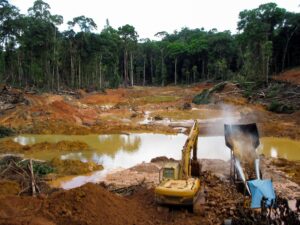How to best halt and reverse deforestation? Largest study of its kind finds answers. Press release

ARLINGTON, Va. (August 16, 2023) – New research from Conservation International offers the most robust understanding yet of which socio-economic, cultural, regulatory and environmental factors have the greatest impact on forests – for better and worse. The study, published today in Review of Environmental Economics and Policy, is the most comprehensive and quantitative of its kind to date that identifies dozens of factors driving deforestation and reforestation.
The study – authored by Jonah Busch of Conservation International and Kalifi Ferretti-Gallon of the University of British Columbia – distills the findings of 320 peer-reviewed studies published up to 2019. That’s more than twice the evidence included in the last comprehensive overview of this kind, published in 2017 by the same authors.
The findings are timely given the increased focus on the need to reduce deforestation and stabilize global temperatures. The new peer-reviewed study – alongside existing Conservation International research that finds the world must reach zero emissions from the land sector by 2030 – can help guide conservation strategies and investments toward policies that are proven to work.
As international efforts to protect and conserve nature continue to gain ground on the world stage – as through the Global Biodiversity Framework’s 30×30 initiative and the Glasgow Leaders Declaration on Forests and Land Use, among others – researchers believe these findings can serve as a guide for leaders across the public, private and nonprofit sectors.
“World leaders have committed to fight climate change by halting and reversing deforestation by 2030. This new study can help guide policies and investment toward actions that support those goals and away from those that do not,” said Busch, lead author and the climate economics fellow at Conservation International’s Moore Center for Science.
What slows deforestation:
Protected areas of many types across many places consistently have lower deforestation. Additionally, when forested area is in Indigenous territory or managed by Indigenous peoples, rates of deforestation are consistently lower. The same is true when payments are made to forest communities or landowners who keep their trees standing, making the forest worth more intact than as timber or farmland. These payments place value on the services that intact forests provide – livelihood opportunities, clean water, rainfall for agriculture and their ability to store climate-warming carbon.
The study also found that rates of deforestation are generally lower in forests with commodity certification programs in place, such as shade-grown coffee and sustainably produced palm oil initiatives. Supply chain programs, in which companies commit to reducing deforestation from their operations, consistently help keep forests intact.
Finally, the study found that enforcement of laws that help protect forests, for example field inspections, fines and monitoring of protected areas, consistently reduce deforestation.
“Left standing, forests are one of our best allies in reducing emissions and cooling a rapidly warming planet,” said Busch. “We provide the strongest evidence yet that land rights for Indigenous communities are reducing deforestation.”
What accelerates deforestation:
The study identifies agriculture and livestock – with their high economic returns – as major drivers of deforestation.
As with the 2017 study, greater accessibility, including lower elevation and proximity to roads and cities, accelerates deforestation, as do greater population and greater wealth. A country’s openness to trade is associated with higher deforestation as well.
The study also analyzed a new variable for the first time in any review study – hotter temperature. It revealed that hotter temperatures are associated with higher deforestation. As this summer has seen global temperature records repeatedly shattered, this novel finding reveals that increased deforestation may be yet another unwelcome effect of global warming.
Several factors were found to have no measurable effect on the rate of deforestation. These included good governance, democracy, peace, land tenure rights and gender balance of the local populations, in addition to the area’s access to nearby water or rainfall.
“Some of these findings surprised us – either because they’d never been found in a peer-reviewed paper until now, or because they went against conventional wisdom,” said Busch. “For example, many people suppose that poorer people are driven to deforestation to meet subsistence needs, but over and over, evidence shows there’s more deforestation in places where people are richer. And when you think about it, it makes sense: the richer you are, the more you’re able to buy machines or hire workers to clear trees.”
“In the face of climate change which renders our forests both more critical and vulnerable, a comprehensive study is our roadmap to effective conservation strategies. It is incumbent upon policy makers, corporations and conservation organizations to prioritize these and invest in sustainable practices as the planet’s future health relies on translating this knowledge into action,” said Ferretti-Gallon, a forestry researcher at the University of British Columbia’s Asia Forest Research Center.
Please see our Reprint Guidelines for details on republishing our articles.

